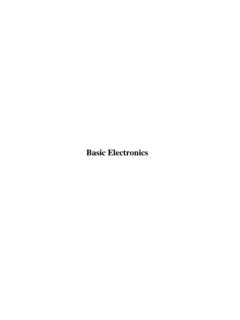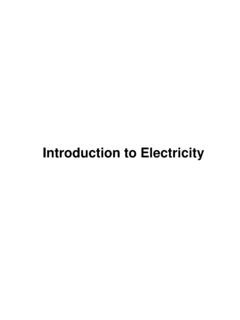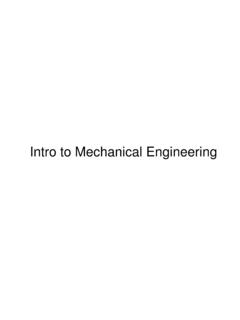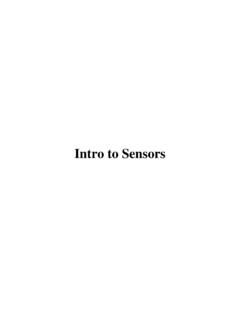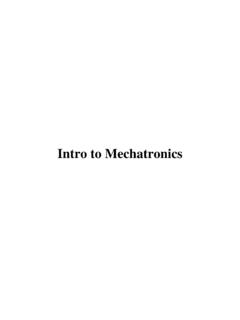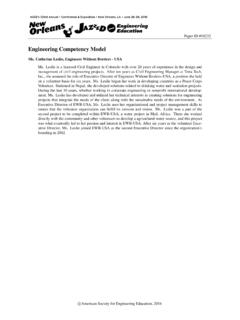Transcription of Introduction to Engineering
1 Introduction to EngineeringEngineering Misconception IFrom: Misconception IIWhich of these things are examples of technology?How do you know something is technology?From: Misconception IIIP lumberElectricianEngineering Misconception IVCarpenterAuto MechanicEngineering Misconception VTrain OperatorPrinting Press OperatorEngineering Misconception VIPC TechnicianBuilding Supervisor/HandymanEngineering Misconception VIIW elderMachinistEngineering Misconception VIIIT radeProfessionScience v/s Engineering Science: Investigation,understanding,anddiscovery ofnature,itscomposition,anditsbehavior( , lawsofnature ) Why Build(experiments,tools,devices,etc.)tol earn Engineering : Manipulating the forces of nature to advance humanity How Learn to build (products and services useful for humans)What is Engineering I Engineering : Latin root, ingeniere, to design or to devise Engineering is designunder constraint device, component, subsystem, system such asAirplaneEngineAir ConditionerHeart ValveSkyscraperMicrocontrollerProsthetic sBridgeWhat is Engineering II Successful Engineering design improves quality of life while working within technical, economic, business, societal, and ethical constraints.
2 Technology: Outcome of engineeringEngineeringDefined I Profession in which knowledge of math and natural sciences, gained by study, experience, and practice, is applied with judgment to develop ways to use, economically, the materials and forces of nature for the benefit of mankind. accreditation Board for Engineering and Technology (ABET)EngineeringDefined II Profession Math and natural sciences Knowledge acquired by study, experience, and professional practice Knowledge applied with judgment Attention must be paid to constraints (economic, materials, forces of nature) Benefit of mankind Not based solely on trial, error, intuitionMechanical EngineeringMachines & MechanismManufacturingMachinery, Production, ManufacturingMechanical EngineeringCompute Aided Analysis & DesignAerodynamic Design of VehiclesAnalysis & DesignMechanical EngineeringWind EnergyFuel CellEnergyMechanical EngineeringUAVS pace ShuttleAir & SpaceMechanical EngineeringRoboticsUtilitiesSystemsCivil EngineeringFoundationStructural AnalysisAnalysis & DesignCivil EngineeringBridgeSkyscraperTunnelConstru ctionCivil EngineeringWater TreatmentEnvironmentalCivil EngineeringTransportationUtilitiesSystem sElectrical EngineeringElectricityElectrical EngineeringElectrical & Electronic CircuitsElectrical EngineeringMotorGeneratorMotors & GeneratorsElectrical EngineeringPower SupplyMeasurementInstrumentsOscilloscope Electrical EngineeringRadarElectrical EngineeringNetworkCommunicationCommunica tion & NetworksEngineeringMajors Aerospace Agricultural Architectural
3 Bioengineering Biochemical Biomedical Ceramic Chemical Civil Computer Construction Cryogenic Electrical Electronic Environmental Industrial Manufacturing Materials Mechanical Mechatronics Metallurgical Mining Naval Nuclear Petroleum Software Structural Systems Textile Tissue What Engineers Do I Research: Advance field Development: Lab to market Testing: Verify integrity, reliability, quality Design: Develop specs for manufacturing, construction, etc. Analysis: Use math models to aid in R&D Systems: Integrate components to produce functioning product Manufacturing: Develop plants and process to make products Construction: Build What Engineers Do II Facility/Plant Operation Maintenance Technical Support Customer Support Sales Consulting Management OthersWhy Engineering in K-12 Real-worldengineeringapplicationsandexam plesconcretizecomplexmathandscienceconce pts Studentsareengagedinexperientiallearning Students creativityischallenged,developed,andenha nced Students softskillsincommunicationandteam-workare developed Studentsarebetterequippedforcollege-leve lworkandcanbecomeactiveparticipantsinani ncreasinglytechnologicalsociety
